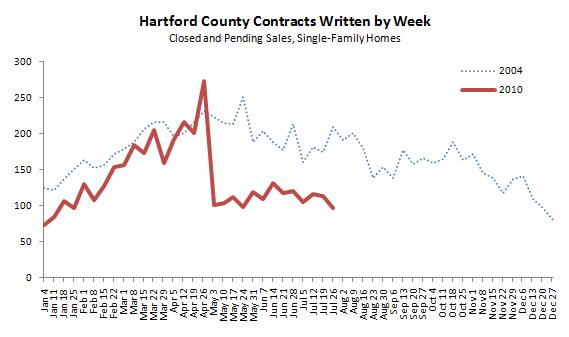The question we get more than anything else is, “Where is the real estate market going?” We try to answer with a quick recap of the current situation, and maybe some thoughts on the near future, but that’s often not enough for the questioner. They want to know the long-term direction of the real estate market. They understand that we can’t predict the future, but they ask anyway. The real answer is that nobody knows, even if they try to tell you otherwise.
What we can talk about are current trends. One metric we noted in a previous post was the number of contracts written by week, using data from the CT Multiple Listing Service, which is deemed reliable but not guaranteed. We’ve been comparing 2010 to 2004, mainly because the calendar-based holidays (for example the 4th of July) fall on the same days of the week for most of the year.

Since the tax credit expired at the end of April, the number of contracts written per week has held relatively steady. This year is clearly less active than 2004, so it will be interesting to see where the trend settles once the impact of the credit fades away. At some point this year’s data should begin to follow the traditional seasonality of the market.
We’ve seen a pick-up in relocation buyers – both our own clients and other agents bringing them through our listings – which means that companies are investing in experienced employees. Hiring trends are an important indicator for the local housing market. People are more comfortable buying a home if they are confident that they’re in a stable job (or could find a different job) and will be able to make their mortgage payments.
Analysis in the most recent Hartford County Property Report showed that inventory levels (table on page 3, last column) in the County were 6.7 months for single-family homes. This means it would take that long to sell all of the current listings if the recent sales pace continued. Six months of inventory is generally considered the boundary between a neutral market and a buyer’s market. More than six months of inventory means that there are lots of homes to choose from – so buyers have an advantage. Less than three months of inventory is considered a seller’s market. No town had inventory levels that low, though Newington was close at 3.7 months. The conclusion from the inventory data is that markets are slightly favoring buyers.
To answer the original question, the real estate market is plugging along. Hopefully the activity level will build towards the end of the summer and settle back into traditional seasonal patterns by the end of the year. But your guess is as good as ours.